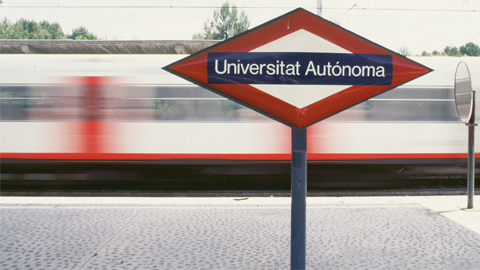Numbers reach 20-year high as use of public transport increases to travel to the UAB

A total of 67% of the UAB community uses public transport to reach the campus, the highest figure since 2001, while private transport means have fallen to 27.5%, the lowest percentage since 2001, according to a UAB survey on mobility habits answered by 4,495 people.
13/06/2023
Of the 43,000 people forming part of the UAB community, almost 7 out of 10 reach the UAB campus by using public transport whereas twenty years ago this figure was 5 out of 10.
According to the results of the UAB University Community Mobility Habits Survey 2023 (carried out by the UAB since 2001 on a biennial basis), there is a consolidation of the upward trend in the use of public transport and a downward trend in reaching the campus by private transport when considering the data from 2001 to 2023. A look back since 2001 shows that the use of public transport has risen from 52.6% in 2001 to 67% in 2023 while the use of private transport has fallen from 43.4% in 2001 to 27.5% in 2023.
In 2023, 67% of the university community uses public transport to reach the campus (up from 64.3% in 2019 and 60.1% in 2017) while private car use has lowered to 27.5% (down from 29% in 2019 and 32.4% in 2017).
Students have increased their use of public transport the most in recent years (from 69.9% in 2019 to 74.3% in 2023), while teaching staff have increased their use of private cars (from 50.3% in 2019 to 55.4% in 2023).
In terms of transport used, there has been an increase in the use of Ferrocarrils de la Generalitat de Catalunya (FGC) train services (from 33.9% in 2019 to 36.3% in 2023) and intercity bus services (from 11.1% in 2019 to 15.8% in 2023), while the use of Renfe has decreased (from 19.4% in 2019 to 15% in 2023). The increases are related to the improvements in the public transport services provided by the main towns from which the university community originates.
It should be noted that 37.5% of the university community has a car but chooses public transport, which shows that there is a competitive offer of public transport from the main towns of origin, although there is still room for improvement. In addition, discounts and the extension of the age limit for buying a T-jove have contributed to the increase in the use of this means of transport.
There is also a downward trend in car sharing. The percentage of people who carpool to get to the UAB between 2001 and 2023 is decreasing: from 38% in 2001 to only 20% in 2023.
With regard to the evaluation of public transport, the rating for all means of public transport has fallen with respect to 2019. The best rated is FGC with 7.6 out of 10, followed by intercity buses with 5.8 and Renfe with 4.4. This rating has always been led by FGC since 2001, ahead of Renfe and intercity buses. However, in this year's survey, Renfe passes for the first time to the end of the list and falls shortly behind intercity buses.
It can also be observed that teleworking has led to a slightly lower recurrence of commuting on campus, especially among PAS and PDI members. The average recurrence on campus is 4.3 days per week (3.57 for teaching and research staff, 4.64 for undergraduate students and 4.13 for administrative and service staff).
When comparing towns of residence, a total of 65% of the university community comes from five towns: Barcelona, 26.4%; Sabadell, 8.9%; Cerdanyola del Vallès, 8.5%; Terrassa, 5.5%; and Sant Cugat del Vallès, 3.6%.
A survey conducted every two years for more than 20 years
This survey, which has been conducted every two years since 2001, is the main tool used to analyse and diagnose daily access to the campus. The survey, which is conducted via an online form, received a total of 4,495 responses from a university community of 43,467 people. The data obtained reflect changes in the mobility patterns of the university community and show an increase in the use of public transport as the preferred means of reaching the university campus.
The survey was presented at the end of May at the last UAB Mobility Committee, the UAB's participatory body for accessibility and mobility issues. It is chaired by the Vice Rectorate for Campus, Sustainability and Territory, and is made up of people from different areas of the University who are related to mobility, representatives of workers and students, and members of public administrations with competences in transport, and road and rail transport service companies.
UAB MOBILITY HABITS SURVEY: Previous editions - Mobility and Transport-UAB Barcelona
This information is related to the following SDG
Affordable and clean energy
Responsible consumption and production
Sustainable cities and communities